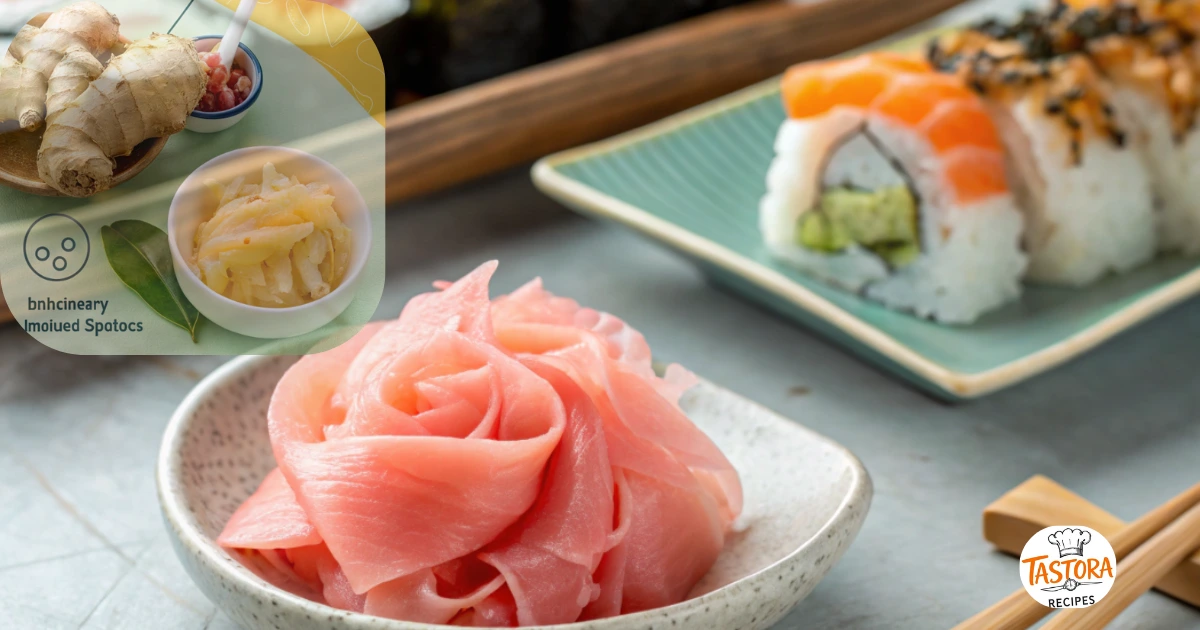Pickled Ginger and Sushi: A Delicious Tradition with Surprising Benefits
The delicate pink slices that accompany your sushi platter aren’t merely a decorative garnish—they’re an essential component of one of the world’s most sophisticated culinary traditions. Pickled ginger, known as “gari” in Japanese, has been the faithful companion to sushi for centuries, serving as both palate cleanser and digestive aid. With its gentle sweet-tart flavor and subtle heat, this unassuming condiment enhances the entire sushi experience, allowing each bite to shine with its intended freshness and flavor. Whether you’re a sushi aficionado or newcomer to Japanese cuisine, understanding the role of pickled ginger reveals a deeper appreciation for the thoughtful harmony that makes sushi not just a meal, but a sensory journey. Join us as we explore the fascinating tradition, surprising health benefits, and proper enjoyment of this pink-hued delicacy that has become an indispensable part of sushi culture worldwide.
What Is Pickled Ginger and Why Is It Served with Sushi?
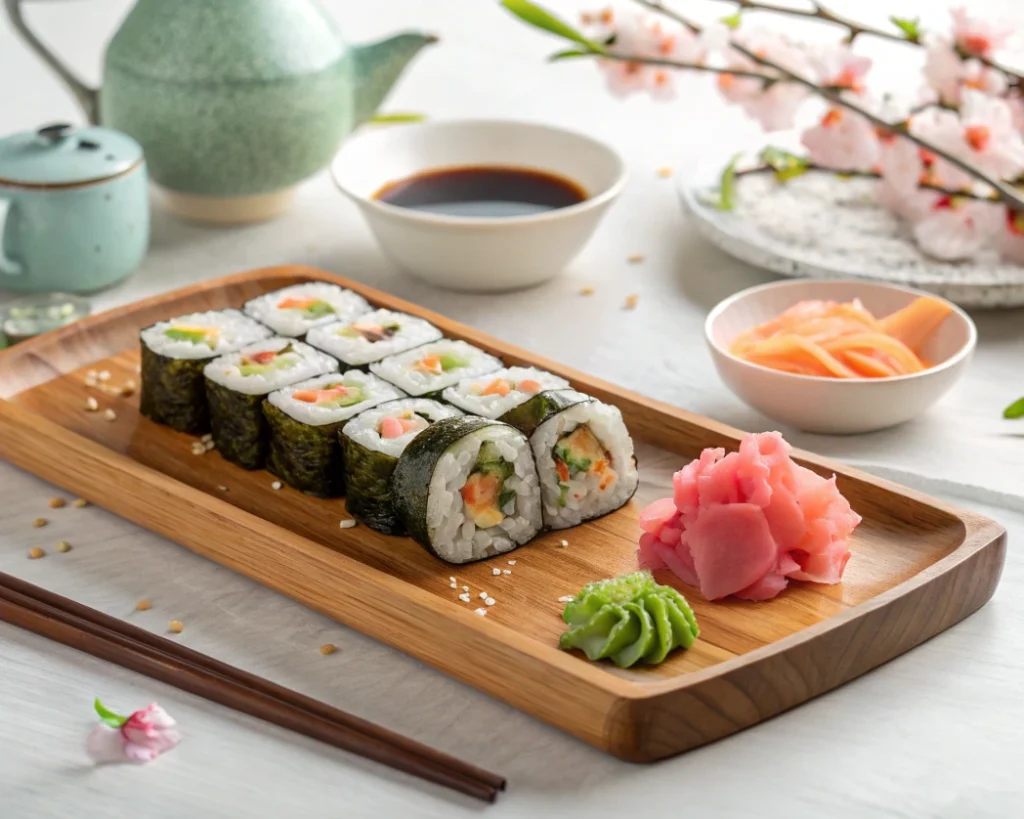
Definition of Gari and Its Origins in Japanese Cuisine
Gari, the Japanese term for pickled ginger, stands as one of the oldest and most respected condiments in traditional Japanese cuisine. Dating back to the Edo period (1603-1868), this preservation technique transformed young, tender ginger root into a versatile accompaniment that could be enjoyed year-round. The characteristic pink hue—which ranges from a subtle blush to a vibrant rose—comes naturally from the pink tips of young ginger, though commercial varieties often use a touch of food coloring to enhance this effect. Made by thinly slicing fresh ginger and marinating it in a solution of rice vinegar, sugar, and salt, gari develops its distinctive sweet-tangy profile that balances the pungency of raw ginger with refreshing acidity. While modern variations exist, traditional gari production remains largely unchanged, with many high-end sushi establishments still preparing it in-house according to centuries-old methods.
The Purpose of Pickled Ginger as a Palate Cleanser
The primary function of pickled ginger in the sushi experience is as a palate cleanser—a gastronomic reset button that plays a crucial role in the progression of a traditional sushi meal. Between different types of fish or sushi preparations, the bright, cleansing properties of gari effectively neutralize lingering flavors, allowing each subsequent piece to be experienced with its full, distinct character. This palate-cleansing effect is particularly important when moving from stronger-flavored fish like mackerel or eel to more delicate options such as sea bream or scallop. The slightly spicy, refreshing quality of ginger stimulates the taste buds while simultaneously clearing away oils and previous taste impressions. In high-end omakase (chef’s choice) dining experiences, this cleansing ritual becomes even more important, as the carefully orchestrated progression of flavors relies on each piece being appreciated on its own merits, uninfluenced by what came before.
How It Complements the Flavors of Sushi
Beyond its role as a palate cleanser, pickled ginger works in harmonious concert with sushi’s other components to create a balanced culinary experience. The gentle sweetness in gari provides a counterpoint to the umami-rich fish, while its subtle acidity complements the seasoned rice without overwhelming it. For fatty fish like salmon or tuna belly, the slight heat of ginger helps cut through richness, refreshing the mouth and enhancing the next bite. Master sushi chefs consider gari an integral element in achieving what Japanese cuisine calls “umami harmony”—the perfect balance of sweet, sour, salty, bitter, and umami flavors that creates a complete taste experience. Rather than being an optional addition, pickled ginger functions as a crucial supporting player in the sushi ensemble, working alongside wasabi and soy sauce to highlight the star of the show: impeccably fresh fish atop perfectly prepared rice.
The Tradition of Pickled Ginger in Sushi Culture
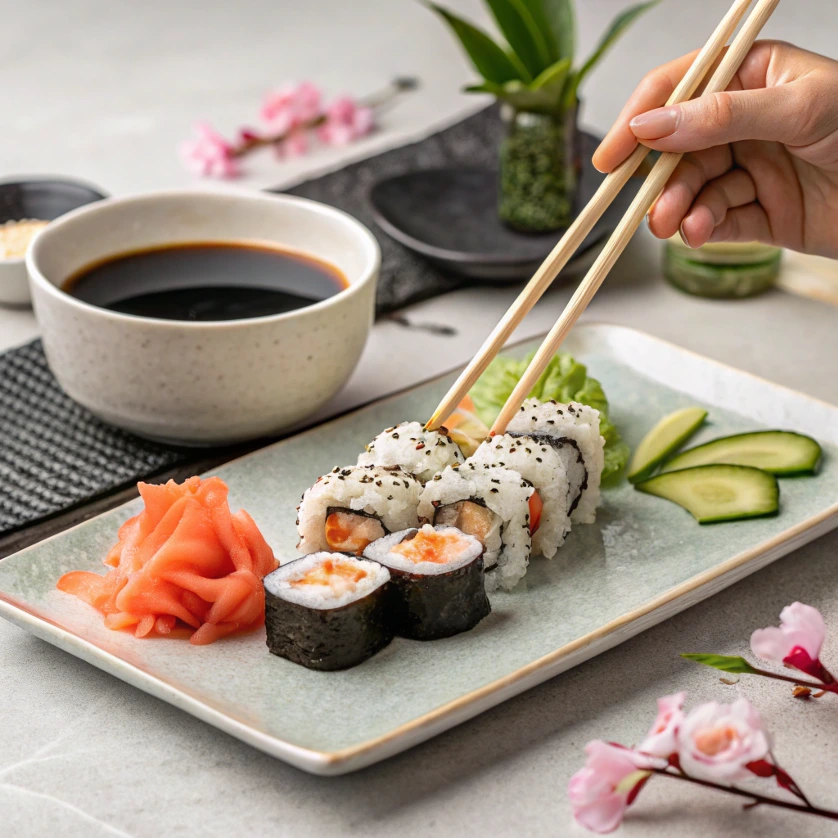
History of Pickled Ginger in Japanese Cuisine
The relationship between pickled ginger and Japanese cuisine stretches back over 1,000 years, with its earliest documented uses appearing in court records from the Heian period (794-1185). Originally valued for its medicinal properties and natural preservation qualities, ginger pickling emerged as a practical method to extend the short growing season of fresh ginger. By the time sushi evolved from its early fermented forms to the nigiri style we recognize today in the 19th century, pickled ginger had already secured its place as an essential accompaniment. Historical accounts from the bustling street food stalls of Edo (modern-day Tokyo) describe sushi vendors offering small portions of gari alongside their hand-pressed fish and rice creations. These early sushi vendors understood that the zingy, palate-refreshing qualities of pickled ginger enhanced their customers’ enjoyment and allowed them to appreciate the subtle differences between different fish varieties. As sushi culture evolved and formalized, so did the preparation and presentation of gari, becoming increasingly refined until it reached the delicate, paper-thin slices we’re familiar with today.
Sushi Etiquette: How and When to Eat Pickled Ginger
Proper enjoyment of pickled ginger follows specific traditions within Japanese dining etiquette. Contrary to popular misconception in Western countries, gari is not meant to be placed directly on top of sushi and eaten together in one bite. Instead, the correct approach is to take a small piece of ginger between different sushi pieces to refresh the palate. This distinction is important—gari serves to prepare your taste buds for the next unique flavor experience rather than to modify the current one. In traditional sushi establishments, particularly in Japan, placing ginger directly on sushi might be considered disrespectful to the chef, as it suggests the carefully balanced flavors require modification. The amount of ginger consumed also follows certain unwritten rules: small portions taken as needed rather than large mouthfuls. In formal omakase settings, the chef may occasionally provide a fresh piece of ginger at strategic points in the meal, signaling transitions between different flavor profiles or categories of fish. Understanding and following these etiquette guidelines not only shows respect for the tradition but also enhances the authentic sushi experience.
The Role of Pickled Ginger in Different Types of Sushi
The function of pickled ginger varies subtly across different sushi styles, adapting to complement each unique presentation. With nigiri sushi—slices of fish atop pressed rice—gari provides a critical palate reset between pieces, particularly important when progressing from lighter white fish to fattier options like tuna or salmon. For sashimi (sliced raw fish without rice), pickled ginger helps balance the pure fish flavor while aiding digestion of the protein. In maki rolls, where multiple ingredients create complex flavor profiles, gari serves as an intermission between different roll varieties, preventing flavor overlap. Chirashi (scattered sushi in a bowl) and temaki (hand rolls) presentations often incorporate a larger portion of ginger on the side, allowing diners to periodically refresh their palates throughout these more substantial sushi formats. In modern fusion sushi establishments, chefs sometimes incorporate pickled ginger directly into certain creative rolls, though traditionalists maintain that gari should remain a separate accompaniment rather than an ingredient. Regardless of the sushi style, the fundamental purpose remains consistent: to enhance the overall dining experience by ensuring each bite is appreciated with a clean, receptive palate.
Health Benefits of Pickled Ginger
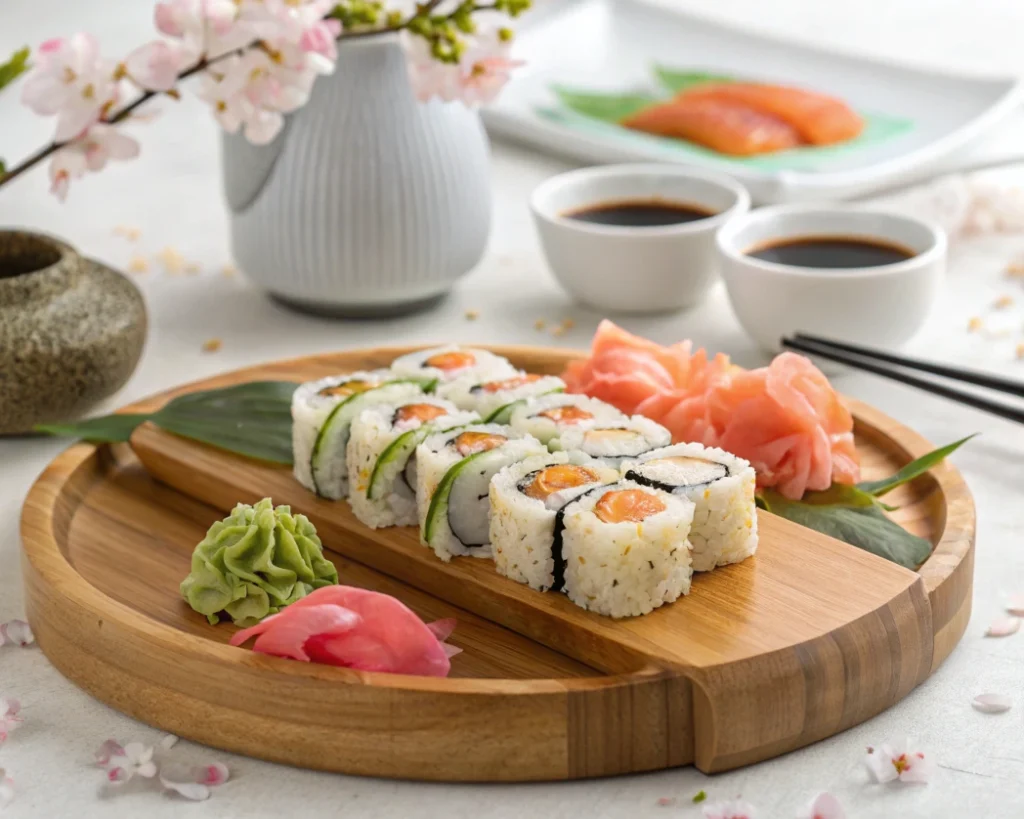
Digestive Benefits: How Ginger Aids Digestion After Sushi
The pairing of pickled ginger with raw fish isn’t merely a matter of flavor—it represents ancient wisdom about digestive health that modern science now confirms. Ginger contains powerful active compounds, particularly gingerols and shogaols, that stimulate saliva production and activate digestive enzymes. This gentle stimulation helps break down proteins in raw fish more efficiently, reducing the risk of digestive discomfort that some people experience after consuming sushi. Additionally, ginger’s natural antimicrobial properties provide a subtle protective effect when consuming raw seafood, though this should never replace proper food safety practices. The slight spiciness of ginger also stimulates gastric motility—the natural contractions that move food through the digestive system—helping to prevent the feeling of heaviness that can sometimes follow a sushi meal. In traditional Japanese medicine (kampo), ginger has long been prescribed for various digestive complaints, from nausea to bloating, making its inclusion alongside raw fish a thoughtful integration of culinary pleasure and digestive wisdom.
Anti-inflammatory Properties and Why It’s Good for Overall Health
Beyond its immediate digestive benefits, the anti-inflammatory compounds in pickled ginger offer remarkable long-term health advantages. The primary bioactive components in ginger—gingerols, paradols, and shogaols—have been extensively studied for their ability to inhibit inflammatory pathways in the body, comparable to some non-steroidal anti-inflammatory medications but without the associated side effects. Regular consumption of ginger, even in pickled form, may help reduce chronic low-grade inflammation associated with conditions like arthritis, heart disease, and certain metabolic disorders. Research suggests these compounds work by blocking specific enzymes and genes that promote inflammation while also neutralizing free radicals through their antioxidant properties. For sushi enthusiasts, this means that the small portions of gari traditionally consumed during a meal contribute to an anti-inflammatory dietary pattern. Interestingly, the pickling process actually preserves many of ginger’s beneficial compounds while making them more bioavailable—meaning the body can absorb and utilize them more efficiently than it might from raw ginger.
Nutrients in Pickled Ginger That Support Immune Health
Pickled ginger contains an impressive array of nutrients and bioactive compounds that bolster immune function beyond its anti-inflammatory effects. Rich in vitamin C, pickled ginger provides antioxidant support that helps maintain the integrity of immune cells and improves their function. The pickling process preserves much of ginger’s natural potassium, magnesium, copper, and manganese content—minerals that play vital roles in immune signaling and pathogen defense. Perhaps most significantly, ginger contains unique compounds like gingerdiols and gingerdiones that have demonstrated direct antimicrobial activity against certain bacteria and viruses in laboratory studies. These compounds appear to work by disrupting the cellular membranes of pathogens or interfering with their ability to adhere to human tissues. While pickled ginger shouldn’t be considered a replacement for a balanced diet or medical treatment, the small amounts consumed during a sushi meal contribute positively to overall immune system support. This immune-enhancing quality of gari adds another dimension to its traditional role in Japanese cuisine—not just enhancing flavor and digestion, but potentially offering protective benefits to those who regularly enjoy sushi.
How Pickled Ginger Is Made
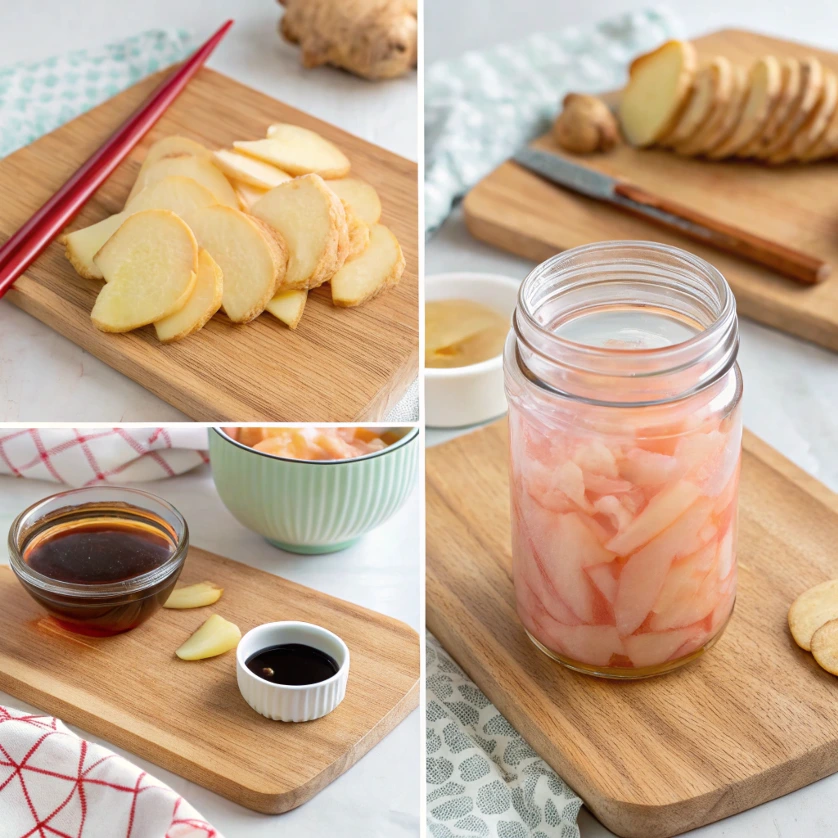
Ingredients for Pickled Ginger and Sushi:
- 1 cup fresh young ginger, thinly sliced
- ½ teaspoon salt
- ½ cup rice vinegar
- 3 tablespoons sugar
- ¼ cup water
Preparation Method:
- Prepare the Ginger:
Peel the ginger and slice it very thinly using a mandoline or sharp knife. Sprinkle the ginger slices with salt and let them sit for about 10 minutes to draw out excess moisture. - Blanch the Ginger:
Bring a small pot of water to a boil. Add the sliced ginger and blanch it for about 30 seconds to remove some of the sharpness. Drain the ginger and set it aside. - Make the Pickling Solution:
In a saucepan, combine the rice vinegar, sugar, and water. Heat over low heat, stirring occasionally, until the sugar is completely dissolved. Remove from heat and let it cool. - Pickle the Ginger:
Place the blanched ginger slices into a clean, sterilized jar. Pour the cooled pickling solution over the ginger, making sure the slices are fully submerged. - Marinate and Store:
Seal the jar and refrigerate the ginger for at least 24 hours to allow the flavors to meld. The ginger will turn a light pink color as it marinates. It can be stored in the refrigerator for up to two weeks.
Ingredients Used in Traditional Japanese Pickling
Authentic Japanese pickled ginger begins with carefully selected raw materials that honor simplicity while achieving complex flavor. The primary ingredient—young ginger root (shin shoga)—is harvested in early summer when the rhizomes are still tender, with thin skin and a naturally pink edge that gives traditional gari its characteristic blush without artificial coloring. The pickling medium consists of just three ingredients: rice vinegar (komezu), which provides acidity with a softer, rounder character than Western vinegars; granulated sugar, which balances the sharpness with subtle sweetness; and sea salt, which enhances flavors while aiding preservation. Premium versions may include a small amount of kelp (kombu) for additional umami depth. Notably absent from traditional recipes are preservatives, stabilizers, or artificial colors—elements commonly found in commercial versions. This minimalist approach reflects the Japanese culinary philosophy of letting natural ingredients express themselves fully. The proportion of these simple ingredients varies by region and family tradition, with Kyoto-style gari featuring more sweetness, while Tokyo preparations tend toward sharper acidity—reflecting each region’s broader culinary preferences.
The Process of Making Gari at Home
Creating authentic pickled ginger at home involves a precise process that transforms raw ginger into delicate, flavor-packed slices. The traditional method begins with selecting young ginger roots, identifiable by their thin, almost translucent skin and small, flat hands rather than the mature, knobbly varieties commonly found in supermarkets. After thorough cleaning, the skin is carefully removed using the edge of a spoon rather than a vegetable peeler to preserve the pinkish tips that give gari its natural coloration. The peeled ginger is then sliced paper-thin—ideally using a mandoline or very sharp knife—with cuts made against the grain to minimize stringiness. These delicate slices are briefly blanched in boiling water for 30-60 seconds, then immediately plunged into cold water to halt cooking while retaining crispness. After draining thoroughly, the slices are placed in a sterilized glass container and covered completely with the pickling solution of rice vinegar, sugar, and salt heated just until dissolved. Traditional preparation requires at least 24 hours of marination before consumption, though many Japanese households prepare larger batches that continue developing flavor for weeks. The characteristic pink color intensifies naturally over the first few days as the anthocyanin pigments in young ginger react with the acidic environment.
How Store-bought Pickled Ginger Differs from Homemade Versions
Commercial pickled ginger products differ from traditional homemade gari in several significant ways that impact both flavor and nutritional value. The most immediately noticeable difference is color—most mass-produced versions rely on food coloring (typically E124/Red #4) to achieve their vibrant pink hue, as they often use mature ginger lacking the natural pink tips of younger roots. Texturally, commercial products frequently undergo more aggressive processing that results in slices that are either too soft or unnaturally crunchy compared to the gentle crispness of traditional gari. The ingredient list reveals further departures: many contain preservatives like sodium benzoate or potassium sorbate to extend shelf life, along with MSG or artificial sweeteners to enhance flavor while reducing sugar content. Industrially produced pickled ginger also typically uses distilled white vinegar rather than rice vinegar, creating a sharper, more pronounced acidity that lacks the subtle complexity of traditional preparations. Some premium store-bought options more closely approximate traditional methods, using young ginger and minimal additives, though these command higher prices reflective of their quality. For sushi enthusiasts seeking an authentic experience, examining labels carefully or preparing gari at home remains the best approach to avoiding the compromises common in mass-market versions.
Best Ways to Enjoy Pickled Ginger with Sushi
The Right Way to Eat Pickled Ginger While Enjoying Sushi
Maximizing the pickled ginger experience involves understanding its proper role in the choreography of a sushi meal. The ideal approach begins with appreciating sushi as the chef intended—each piece consumed in a single bite, either by hand or with chopsticks, shortly after preparation. Between different sushi pieces, take a small slice of gari, chewing it briefly to release its palate-cleansing properties before moving on to the next selection. This rhythmic alternation between sushi and ginger maintains the distinct character of each fish variety or roll combination. In higher-end establishments, sushi masters often serve pieces in a deliberate progression from lighter to more robust flavors, making the cleansing function of gari particularly important. When drinking sake or beer with sushi, a small piece of ginger can also refresh the palate between sips and bites. Some connoisseurs recommend a specific sequence: sushi, followed by ginger, then a sip of green tea to completely reset the taste buds before the next piece. This methodical approach transforms a casual meal into a mindful dining experience where each component plays its proper role in the orchestrated harmony of flavors.
Common Mistakes People Make When Eating Pickled Ginger
Several misunderstandings about pickled ginger can diminish the authentic sushi experience. The most prevalent error—placing gari directly on top of sushi before eating—fundamentally alters the carefully balanced flavors that sushi chefs work to create. This practice essentially drowns out the subtle notes of the fish with the assertive flavor of ginger, defeating its intended purpose as a palate cleanser between different varieties. Another common mistake is consuming large quantities of ginger simultaneously, which overwhelms the taste buds rather than refreshing them. Some diners incorrectly mix ginger into soy sauce, creating a combination that masks the clean, distinct flavors that should characterize each element of the sushi experience. Western diners sometimes treat gari as a primary condiment rather than an interlude between pieces, piling it onto each bite in quantities that would surprise traditional Japanese diners. Finally, many people overlook the ginger entirely, missing out on its palate-cleansing benefits and digestive advantages. Understanding that each component of a sushi meal—the fish, rice, wasabi, soy sauce, and ginger—has a specific purpose and proper usage transforms a casual dining experience into an appreciation of one of the world’s most refined culinary arts.
Other Dishes That Pair Well with Pickled Ginger Besides Sushi
The versatility of pickled ginger extends well beyond its traditional role alongside sushi, complementing a surprising variety of both Asian and Western dishes. Within Japanese cuisine, gari enhances cold noodle dishes like soba or somen, providing bright counterpoints to their earthy buckwheat or wheat flavors. It also makes an excellent addition to rice bowls, particularly those featuring grilled fish or chicken, where it cuts through richness while adding complexity. In Chinese culinary applications, pickled ginger pairs beautifully with congee (rice porridge) and dim sum selections, especially those with heavier flavor profiles. Beyond Asian traditions, innovative chefs have discovered that the sweet-tart profile of pickled ginger complements many Western preparations—adding surprising dimension to roasted pork or duck, brightening seafood soups and chowders, or enlivening simple salads when finely julienned. Pickled ginger also makes an unexpectedly wonderful addition to certain cocktails, particularly those featuring bourbon or rye whiskey, where its spicy-sweet characteristics amplify the spirits’ caramel notes. For home cooks looking to incorporate this versatile condiment more broadly, finely chopped pickled ginger adds complexity to vinaigrettes, seafood marinades, and even fruit-based desserts where its gentle heat balances sweetness.
Conclusion Pickled Ginger and Sushi
Pickled ginger stands as so much more than a simple garnish on the side of your sushi platter—it represents the thoughtful detail and balance that defines Japanese cuisine. Through centuries of refinement, this humble condiment has become an essential player in the sushi experience, offering not just its distinctive sweet-spicy flavor but also contributing meaningful benefits to digestion, inflammation reduction, and overall well-being. By understanding the proper way to enjoy gari—as a palate cleanser between different types of fish rather than as a topping—sushi enthusiasts can elevate their appreciation of this sophisticated culinary art form. Whether you’re a sushi novice or connoisseur, taking the time to properly incorporate pickled ginger into your meal honors a tradition that masterfully balances flavor, function, and health. The next time you sit down to a sushi meal, pay particular attention to those delicate pink slices—they’re not just there for decoration, but to complete an experience centuries in the making.
Are you ready to try this recipe?
There are no reviews yet. Be the first one to write one.

